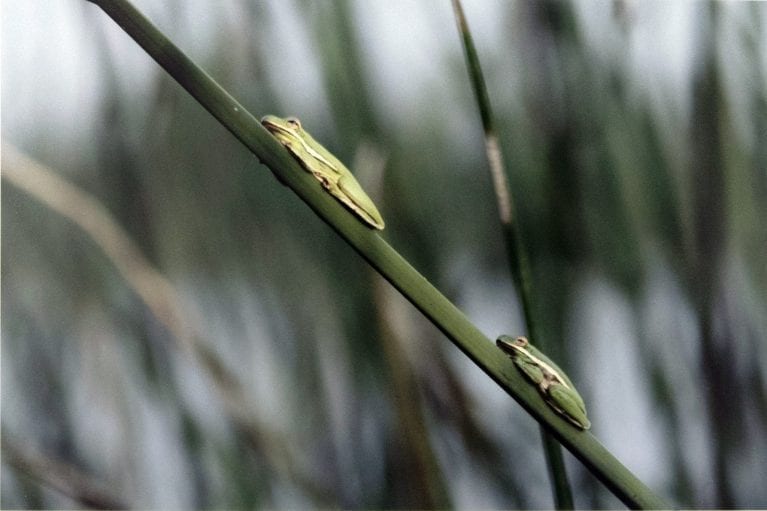Español abajo
In this Movement Monday Activity, recreate sounds found in nature.
Download Activity
John Taylor, Green Frogs, Digital Print, 2019
The ability to hear is one of the five senses of the body. Using our ears, we have the ability to listen to music or communicate with others. Many things in nature use sounds to communicate, such as a birdcall or dog bark. Other sounds occur due to movement, such as the sound of a waterfall or the sound of a hummingbird’s wings.
Instructions
Step 1: With the help of a parent or guardian, take a walk around your neighborhood. What sounds do you hear? What sounds are loud and what sounds are quiet? What sounds occur in nature and what sounds are man-made?
Step 2: Once you return home, think of three sounds that stood out to you. See if you can recreate the sounds yourself. Was the sound high-pitched or a lower tone? Did it have a rhythm? For example, if you move your feet quickly, does it sound like rain falling on the roof, or would clapping your hands sound more like rain? Can you whistle like a bird?
Step 3: Once you have recreated the sounds of your choice, perform your sounds to your friends and family. Can they guess what sound you are imitating?
Step 4: Have your friends and family recreate sounds of their own and see if you can guess them!
Lunes de movimiento: Exploración de los sonidos de la naturaleza
En esta actividad de Lunes de movimiento, recrea los sonidos que encuentres en la naturaleza.

John Taylor, Green Frogs, Digital Print, 2019 | John Taylor, Ranas Verdes, impresión digital, 2019
La capacidad de oír es uno de los cinco sentidos del cuerpo. Utilizando nuestros oídos, tenemos la capacidad de escuchar música o comunicarnos con los demás. Muchas cosas en la naturaleza usan sonidos para comunicarse, como el canto de un pájaro o el ladrido de un perro. Otros sonidos se producen debido al movimiento, como el sonido de una cascada o el sonido de las alas de un colibrí.
Instrucciones
Paso 1: Con la ayuda de un padre o tutor, da un paseo por tu vecindario. ¿Qué sonidos escuchas? ¿Qué sonidos son fuertes y cuáles son silenciosos? ¿Qué sonidos se producen en la naturaleza y cuáles son creados por el hombre?
Paso 2: Una vez que regreses a casa, piensa en tres sonidos que te llamaron la atención. Fijate si puedes recrear los sonidos tú mismo. ¿El sonido era agudo o grave? ¿Tenía ritmo? Por ejemplo, si mueves los pies rápidamente, ¿suena como lluvia cayendo sobre el techo o aplaudir sonaría más como lluvia? ¿Puedes silbar como un pájaro?
Paso 3: Una vez que hayas recreado los sonidos que elegiste, interpreta tus sonidos para tus amigos y familiares. ¿Pueden adivinar qué sonido estás imitando?
Paso 4: ¡Haz que tus amigos y familiares recreen sus propios sonidos y fijate si puedes adivinarlos!
¡VE MÁS ACTIVIDADES DIVERTIDAS PARA NIÑOS PARA HACER EN CASA EL O BLOG!
¿PREGUNTAS? ENVÍA UN EMAIL A EDUCATION@OGDENMUSEUM.ORG.
Translation by Agostina Coll
